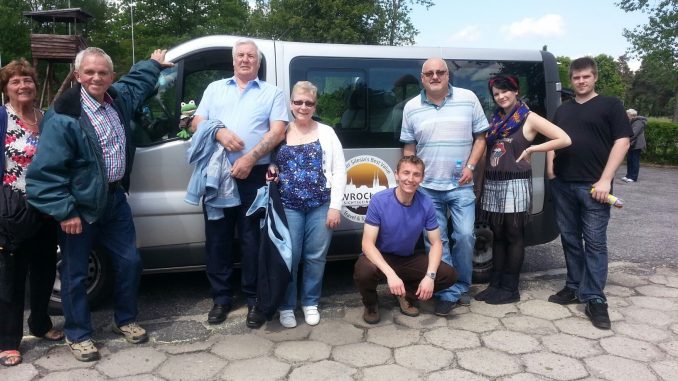
The Great Escape
We travelled from Wroclaw Poland on a day trip with our good friends at Wroclaw Sightseeing Tours. We were picked up from our hotel early morning and driven in one of there luxury mini buses. The Driver who was also our tour guide spoke fluent English and was extremely knowledgeable about the history and geography of the camp. One nice touch was he had bought for our trip a nice polish cake with yummy chocolate for each of us washed down by a nice cold drink. A nice touch we thought.
The Museum
We arrived at the museum of the Escape first where there was reproduced prisoner hut and a small replica tunnel along with a cart which you could use reproducing an experience of what it would of been like in the tunnel itself. the museum itself was filled with artifacts from the camp and WW2.
Stalag Luft III
From the Museum we travelled another couple of miles through woodland to the remains of the camp now mostly restored woodland. Although there are several places of interest to visit and see. The entrances to the tunnels and the exits are clearly marked with stone plaques. We were taken around the perimeter of the camp and was some what surprised at the sheer size of it. From the camp we were taken to a war cemetery for the fallen. From here we were taken to the Railway station which most people would remember from the film Great Escape. This Station looks exactly the same now (Its probably never been painted). All in all a marvelous day trip made all the better by our guide and driver from Wroclaw Sightseeing Tours. We would highly recommend them for there tours. We will be using them again next time we are in Wroclaw. As we plan to visit Colditz and Dresden (Watch this space).
The History
An audacious plan for a mass escape was put together in early 1943 by the man who became known as Big “X” – Squadron Leader Roger Bushell – a captive RAF officer.
The Squadron Leader was being held in North compound, the home of British airmen. In charge of the Escape Committee, Bushell channelled the effort into probing for weaknesses and looking for opportunities and shocked the committee with the scope of his plan. His plan was to dig three tunnels at the same time and to attempt to get 200 men out in a single attempt.
The simultaneous digging of the tunnels – named Tom, Dick and Harry – was aimed to give an advantage to the escapees. If any one of them was discovered by the Germans, it was felt that the Germans would scarcely imagine that another two would also be in progress.
The most revolutionary part of the plan was not just the scale of the construction, but the large number of men that Big “X” wanted to go through the tunnels.
Previous escape attempts had involved up to a dozen or so PoWs, but Bushell was aiming to get more than 200 out, all wearing civilian clothes and possessing a complete range of forged papers and escape equipment.
It was an unparalleled idea and would require exceptional organisation. The first of the three tunnels – Tom – began in a darkened corner of a hall in one of the buildings. The entrance to Dick was carefully hidden in a drain sump in one of the washrooms. Harry’s entrance was hidden under a stove. More than 600 prisoners were involved in their construction.
Tunnel construction
The tunnels were dug very deep, about 30 feet below the surface. Each tunnel was very small, about 2 feet square, with larger chambers created to house an air pump, a workshop and staging posts in each tunnel.
The difficult sandy subsoil in the tunnels was held up with pieces of wood collected from all over the camp. One of the main sources was the camp’s beds. Prior to the start of tunnelling, each bed had about twenty boards supporting the mattress. When the escape happened, each bed was left with only about eight boards. A variety of other pieces of wooden furniture were taken from around the camp.
Other materials were also used, including Klim cans. These were powdered milk tin cans that had been supplied by the Red Cross in food parcels. The metal of the cans was fashioned into a number of different tools and items, including scoops and candle holders. The main use of the Klim tins, however, was in the construction of the extensive ventilation ducting in all three tunnels.
Candles themselves were fashioned by skimming the fat off the top of soup served at the camp and putting it in tiny tin vessels. Wicks were made from old and worn clothing.
As the tunnels grew in length, a number of innovations made the progress easier and safer. One important issue was ensuring that the tunneller had enough oxygen to breathe and keep the lamps lit. A pump was built to push fresh air along the ducting into the tunnels – invented by Squadron Leader Bob Nelson of 37 Squadron. The pumps were built of odd items including major bed pieces, hockey sticks, and knapsacks — as well as the versatile Klim tins.
As progress continued, electric lighting was installed and hooked into the camp’s electrical grid. The tunnellers also installed small rail car systems for moving sand more quickly. The rails were key to moving an approximate 200 tons of sand over twelve months. They also reduced the time taken for tunnellers to reach the digging faces.
With three tunnels being dug at the same time, the need to remove the excavated sand had to be addressed. The standard disposal method was to discreetly scatter it on the surface soil and mix it in by walking around. Small pouches, made of old socks, were attached inside the PoWs’ trousers. As the prisoners walked around, the sand was scattered and mixed in with the existing top soil.
On occasions, the PoWs would pour sand into the small allotment that they had been given to tend. As one man turned the soil, another would release sand while the two appeared to carry on a normal conversation. The prisoners wore greatcoats to conceal the bulges made by the socks and were referred to as “penguins” because of their resemblance to the flightless bird. More than 200 penguins were recruited and they went on to make an estimated 25,000 trips.
The camp commanders were aware that something major was going on, but all attempts to discover tunnels failed. To try and foil any escape attempts, 19 of their top suspects were transferred, without warning, to Stalag VIIIC. Of those, only six were actually involved with tunnel construction.
As time passed, the disposal of sand on the surface was discontinued as the Germans became too efficient at catching prisoners using this method. A camp extension was built that, unbeknownst to the Germans, covered the planned exit for Dick and this led to the decision to start filling the tunnel up.
As the tunnel’s entrance was very well-hidden, Dick was also used as a storage room for a variety of items such as maps, postage stamps, forged travel permits, compasses, and clothing such as German uniforms and civilian suits.
Perhaps one of the most surprising aspects of the whole enterprise is the number of friendly guards who co-operated in supplying railway timetables, maps and the large number of official papers that were used to create forgeries. Genuine civilian clothes were also obtained by bribing German staff with cigarettes, coffee or chocolate. These clothes were to be used by escaping prisoners to travel away from the prison camp more easily.
The PoWs eventually ran out of places to hide the sand and the arrival of the winter snow made it impossible to scatter it over the ground. Underneath the seats in the theatre was a huge enclosed area – seat 13 was hinged and the ongoing sand problem solved.
As the war progressed, the German prison camps began to be overwhelmed with American prisoners. The Germans decided that new camps would be built specifically for the US airmen. In an effort to allow as many people to escape as possible, including the Americans, efforts on the remaining two tunnels increased.
This increased activity drew the attention of the Germans, and the discovery of the entrance to Tom made it the 98th tunnel to be found in the camp. Guards hiding in the woods watching the “penguins” noticed sand was being removed from the hut where Tom was located. Work on Harry ceased and did not resume until January 1944.
The “great escape”
Harry, the last remaining tunnel, was finally ready in March 1944. The escape attempt had originally been planned for the summer as good weather was a large factor of success. In early 1944, though, the Gestapo visited Stalag Luft III and demanded increased efforts in detecting possible escape attempts. Big “X” moved the escape attempt up, so that is was to be made as soon as the tunnel was ready.
Of the 600 or so PoWs who had worked on the tunnels, only 200 could be included in the plan. The Allied PoWs were separated into two groups.
The first group of 100, called “serial offenders”, were guaranteed a place and included good German speakers or had a history of escapes, plus those who were considered to have put in the most work on the tunnels.
The second group of 100, thought to have very little chance of success, had to draw lots to determine inclusion. Called “hard-arsers”, they would be required to travel by night as they spoke little or no German and were only equipped with the most basic fake papers and equipment.
The escapees had to wait about a week for a moonless night so that they could leave under the cover of complete darkness. Finally, on Friday 24 March 1944, the escape attempt began and as night fell, those allocated a place in the tunnel moved to Hut 104.
A setback was encountered immediately as the exit trap door of Harry was found to be frozen solid. Getting the door to open delayed the start of the escape for an hour and a half.
An even bigger problem presented itself when it was discovered that the tunnel had come up short. It had been planned that the tunnel would reach into a nearby forest but at 10.30pm, the first man out emerged just short of the tree line and close to a guard tower.
As the temperature was below freezing and snow was heavy on the ground, any escapee would leave a dark trail while crawling to cover. The need to avoid sentries meant that instead of the planned one man every minute, the attempt was reduced to around ten per hour. With all of these problems, it was decided that no potential escapee with a number higher than 100 could make their attempt before daylight. As these PoWs would be shot if caught trying to return to their own huts, the men changed into their own uniforms and got some sleep. An Allied air raid then caused the camp’s (and the tunnel’s) electric lighting to be shut down slowing the escape even more. At around 1 am, the tunnel collapsed and had to be repaired.
Even with these problems, 76 men crawled through the tunnel to initial freedom. Finally, at 4:55am on 25 March, the 77th man was seen emerging from the tunnel by one of the guards.
Those already in the trees began running while a New Zealand Squadron Leader Leonard Henry Trent, VC, who had just reached the tree line stood up and surrendered. The guards had no idea where the tunnel entrance was, so they began searching the huts, giving the men time to burn their fake papers.
Hut 104 was one of the last huts searched and, despite using dogs, the guards were unable to find the entrance. Finally, German guard Charlie Pilz crawled the length of the tunnel but found himself trapped at the other end. Pilz began calling for help and the prisoners opened the entrance to let him out, finally revealing the location.
An early problem for the escapees was that most of them were unable to find the entrance to the railway station until daylight revealed it was in a recess in the side wall of an underground pedestrian tunnel. Consequently, many of them missed their night trains and either decided to walk across country or wait on the platform in daylight. Another unanticipated problem was that this March was the coldest recorded in 30 years and snow lay up to five feet deep, the escapees had no option but to leave the cover of woods and fields and use roads.
After the escape
Following the escape, the Germans took an inventory of the camp and found out just how extensive the operation had been. 4,000 bed boards had gone missing, as well as the complete disappearance of 90 double bunk beds, 635 mattresses, 192 bed covers, 161 pillow cases, 52 20-man tables, 10 single tables, 34 chairs, 76 benches, 1,212 bed bolsters, 1,370 beading battens, 1219 knives, 478 spoons, 582 forks, 69 lamps, 246 water cans, 30 shovels, 1,000 feet of electric wire, 600 feet of rope, and 3,424 towels. 1,700 blankets had been used, along with more than 1,400 Klim cans. The electric cable had been stolen after being left unattended by German workers; as they had not reported the theft, they were executed by the Gestapo. From then on each bed was supplied with only nine bed boards which were counted regularly by the guards.
Of 76 escapees, 73 were captured. Hitler initially wanted the escapees to be shot as an example to other prisoners, as well as Commandant von Lindeiner, the architect who designed the camp, the camp’s security officer and the guards on duty at the time. Hermann Göring, Field Marshal Keitel, Major-General Westhoff and Major-General von Graevenitz, who was head of the department in charge of prisoners of war, all argued against any executions as a violation of the Geneva Conventions. Hitler eventually relented and instead ordered Himmler to execute more than half of the escapees. Himmler passed the selection on to General Artur Nebe. Fifty were executed singly or in pairs. Roger Bushell – Big “X” – was shot by Gestapo official Emil Schulz just outside Saarbrücken, Germany.
Seventeen were returned to Stalag Luft III, four were sent to Sachsenhausen concentration camp, where they managed to tunnel out and escape three months later but were recaptured after several weeks and returned to Sachsenhausen. Two were sent to Oflag IV-C Colditz.

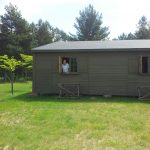

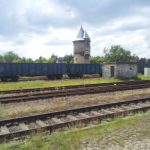
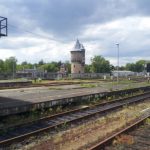
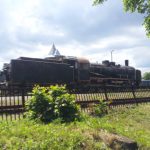
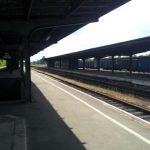

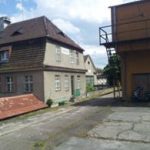

Leave a Reply
You must be logged in to post a comment.